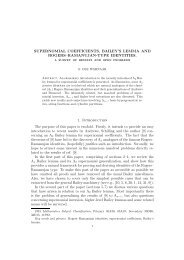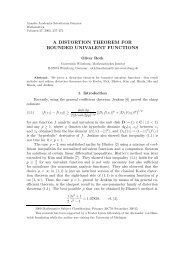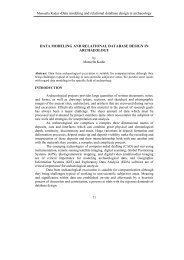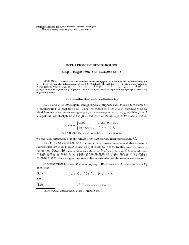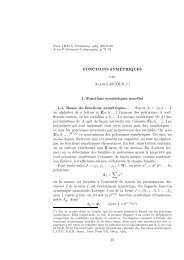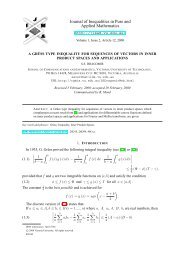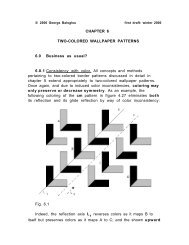THE COMBINATORICS OF THE AL-SALAM-CHIHARA q ...
THE COMBINATORICS OF THE AL-SALAM-CHIHARA q ...
THE COMBINATORICS OF THE AL-SALAM-CHIHARA q ...
You also want an ePaper? Increase the reach of your titles
YUMPU automatically turns print PDFs into web optimized ePapers that Google loves.
<strong>THE</strong> <strong>COMBINATORICS</strong> <strong>OF</strong> <strong>THE</strong> <strong>AL</strong>-S<strong>AL</strong>AM-<strong>CHIHARA</strong> q-CHARLIER POLYNOMI<strong>AL</strong>S 5because there are nine integers of label −1, three cycles of label −x, two cycles of labela, five Charlier-inversions, i.e. (5, 3), (5, 4), (5, 2), (3, 2), (4, 2).One can restate Theorem 1 as follows.Corollary 3. The q-Charlier polynomial C n (x, a; q) is the generating function of Charlierpermutationsof [n]:C n (x, a; q) = ∑ τwhere τ runs through all permutations of [n].w(τ),3. The momentsFor the Charlier polynomials Cn(x), a the n th moment µ n is the generating function forset partitions of {1, 2, · · · , n} according to the number of blocks (see (1.4)). There is anatural q-analogue for the polynomials Cn(x; a q) [6, Eq. (3.1)], whose n th moment isn∑µ n = S q (n, k)a k .k=1Note that S q (n, k) is the most natural q-analogue of the Stirling numbers of the secondkind, and may also be interpreted as a generating function for set partitions with k blocksaccording to a q-statistic. It has a remarkably simple expression as a single sum [6, Eq.(3.3)]. In this section we identify an appropriate q-statistic on set partitions which yieldsthe n th moment µ n for C n (x, a; q), and give an explicit formula for it.Recall that if π is a partition of M = {1, . . . , m}, then a crossing of π is a quadruple(a, b, c, d) of elements of M such that a < b < c < d, the elements a, c are in someblock of the partition and b, d are in another block. For two elements e and f of M,with e < f, we say that f follows e in π if e and f belong to the same block of π, andthere is no element g of this block with e < g < f. We define a restricted crossing tobe a crossing (a, b, c, d) such that c follows a and d follows b. Similarly a nesting is aquadruple (a, b, c, d) of elements of M such that a < b < c < d, the elements a, d are insome block of the partition and b, c are in another block. We define a restricted nestingto be a nesting (a, b, c, d) such that d follows a and c follows b. The restricted crossingsand nestings have a natural interpretation in the graphic line representation of partitions.This representation consists in drawing the m points on the x-axis in the plane and, if ffollows e, joining the point e and f by an arc above the x-axis.For instance, the graph of π = {1, 6, 10} − {2, 3, 9} − {4, 7} − {5, 8} is the following:123456Let rc(π) (resp. rn(π)) be the number of restricted crossings (resp. restricted nestings)of a partition π. The number of blocks of π is denoted by block(π). For the above π78910



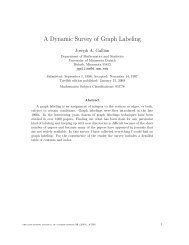

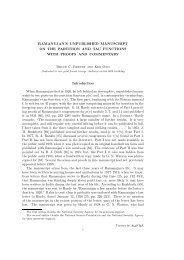
![(.,t ] and [s, .) , where [s,t ] = {s' GT; s ¤ s' ¤ t} , (.,t ] = {s' GT; s' ¤ t} and ...](https://img.yumpu.com/43303393/1/184x260/t-and-s-where-st-s-gt-s-a-s-a-t-t-s-gt-s-a-t-and-.jpg?quality=85)
